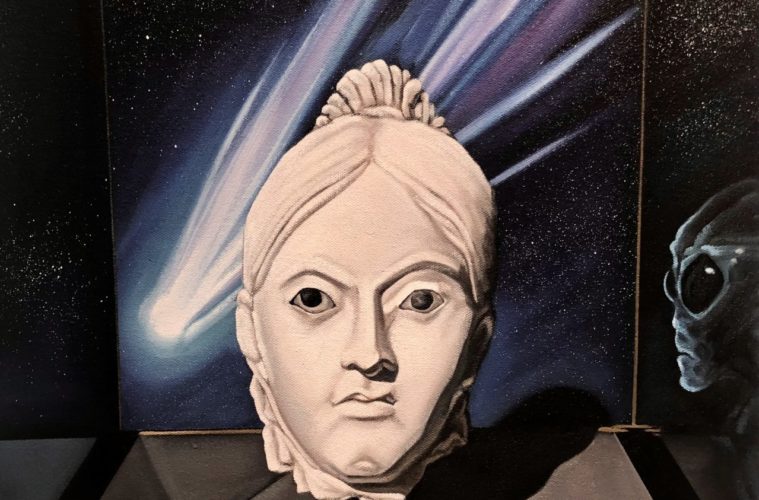Throughout history, and across cultures and continents, there have always been women, sibyls, who possessed secret, sacred knowledges from the healing arts to folklore — and especially clairvoyance. Depending on the context, these figures might be revered, worshiped, sought out or feared, shunned and persecuted, but they always helped usher in the future. Taking this historical archetype as its framework, Cantos of the Sibylline Sisterhood gathers a group of feminist, queer and trans artists working in a range of mediums, all of whom tap into that ancestry, setting ages-old potencies against modern-day threats.
In the many crosscurrents of theme, motif, material and symbolism, the group does function like a sisterhood, as each artist addresses interrelated issues of permeable identity and power dynamics playing out in their diverse cultural milieus and lived experiences, as well as in their individual styles and mediums. One thing they share is the understanding that the current halls of power could use some renovation, and that it’s long past time to listen to women — or better yet, lose the stunted binary and embrace a more ambiguous pluri-potentiality for a future that is actually new, and whose freedoms are truly available to all.
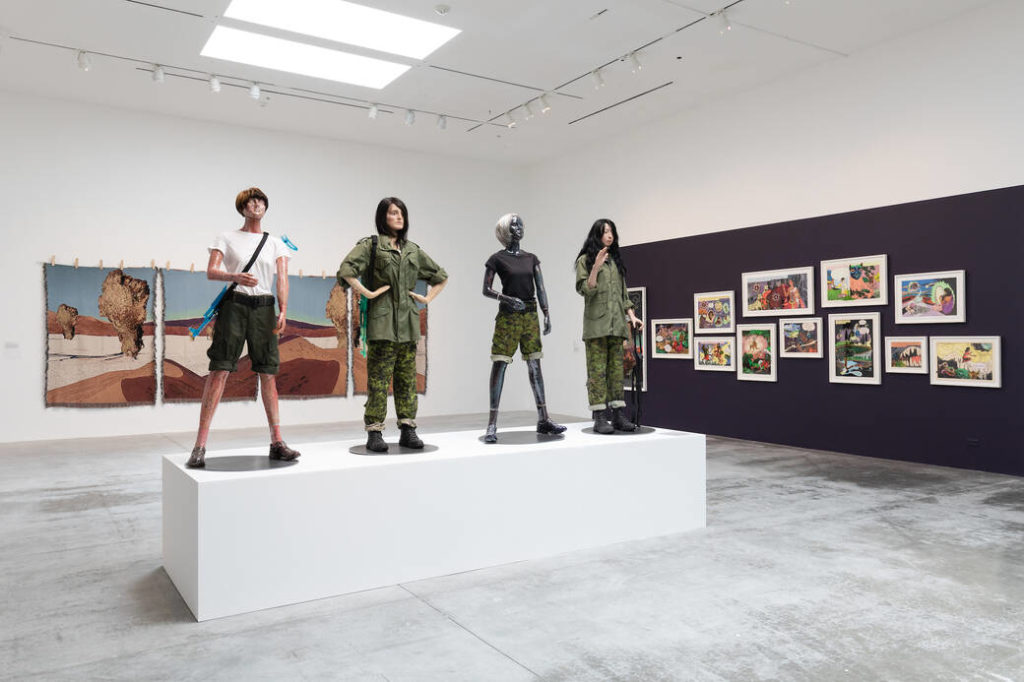
April Bey, Mai-Thu Perret, Chitra Ganesh in Cantos of the Sibylline Sisterhood, Installation view (Courtesy of ArtCenter College of Design. Photo: Juan Posada)
For now, that future is written in the language of fantasy, myth, sci-fi, dreams and visions — and in this compelling exhibition, in painting, collage, sculpture, textile, photography, video, installation, performance and printmaking. Planned by curators Julie Joyce, director of ArtCenter Galleries, and Christina Valentine, curator of Exhibitions before the pandemic, like many such exhibitions coming to fruition in its aftermath, the spiritual, political, personal and societal messaging of Cantos is timelier than ever. Most remarkable perhaps is how this urgent message is delivered with thoughtful wit, allure, flights of fanciful imagination, exuberance and even joy.
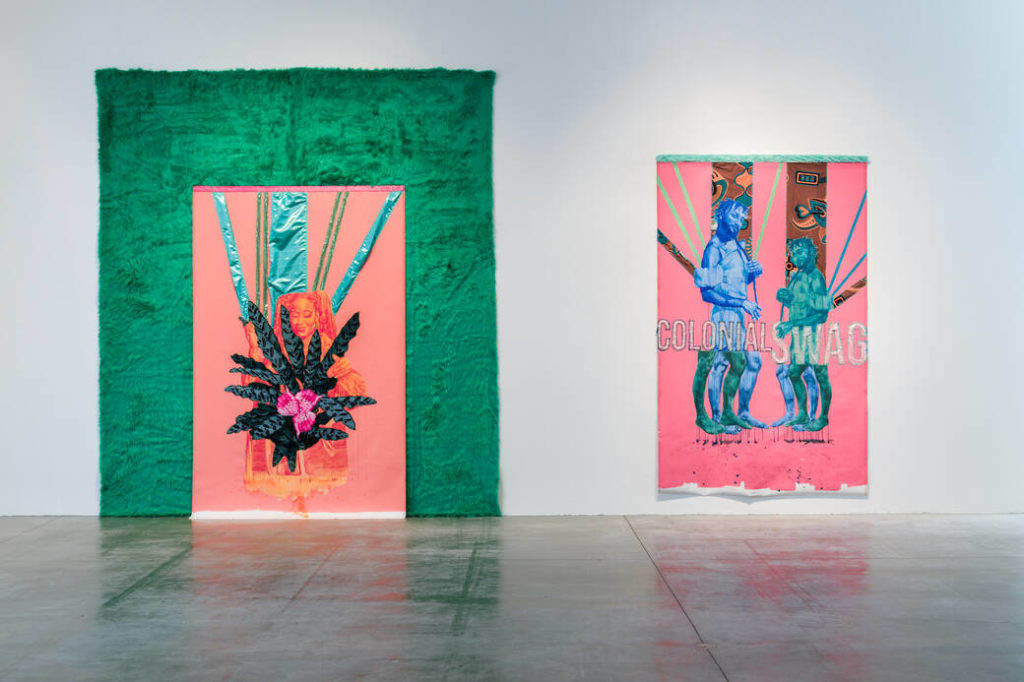
April Bey: Your Failure is Not a Victory for Me (2022) and Enjoyment (2020), from the Colonial Swag series, in Cantos of the Sibylline Sisterhood. (Courtesy ArtCenter College of Design. Photo: Ruben Diaz)
Throughlines and crosscurrents abound in a multilayered conversation between and among the artists and their work, reinforcing the rhizomatic structure implied by “sisterhood” and the resonant harmony of “cantos.” For example, large-scale mixed-media tapestries from April Bey’s Atlantica world-building project claim the hefty material presence of historical wall-hangings such as might chronicle the faces and episodes of its history. But in their decolonized imagery, elevated swagger, and activated palette — as well as in the borrowing of somber civic memorial iconography in Poulet Wing War Memorial Park — Bey deploys this visual and material language to generate an improved, inclusive, empathetic, and frankly way more fabulous version of the timeline and the planet.
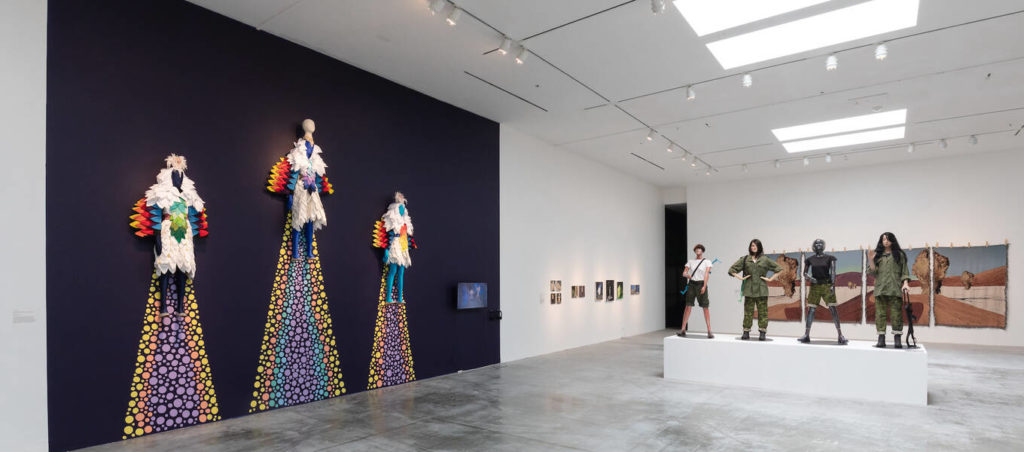
Saya Woolfalk’s Aerial Display (Blossoming) (2012) and The Empathics (2013); Erica Ryan Stallones’ Visitation Station series (2020); Mai-Thu Perret’s Les guérillères IX, IV, VII and VIII (2016); and April Bey’s Poulet Wing War Memorial Park (2021). (Courtesy ArtCenter College of Design. Photo: Juan Posada)
Bey’s tapestries bookend the main exhibition space, whose center is occupied by a phalanx of costumed mannequin sculptures by Mai-Thu Perret. In her Les guérillères series, female figures dressed in versions of military gear are themselves made of ostensibly delicate materials like wicker, silicone and ceramics. This both challenges the very notion of the fragile female while also critiquing the nexus of conflict, capital and oppressive gender norms. Like Bey’s figures, these women inhabit and protect a utopian realm, in this case, The Crystal Frontier. Facing this array are the ascendant mannequin-like wall sculptures in the video and installation by Saya Woolfalk, who also has created a utopian world for her figures to inhabit. These are spiritually and technologically advanced people known as The Empathics, whose purpose and special gift is to metamorphosize between realms of humanity, nature and technology, in the name of healing the planet and the psyche. Their avian and mycellic physical forms glimmer and levitate through a dense cosmos that speaks to both folklore and science fiction.
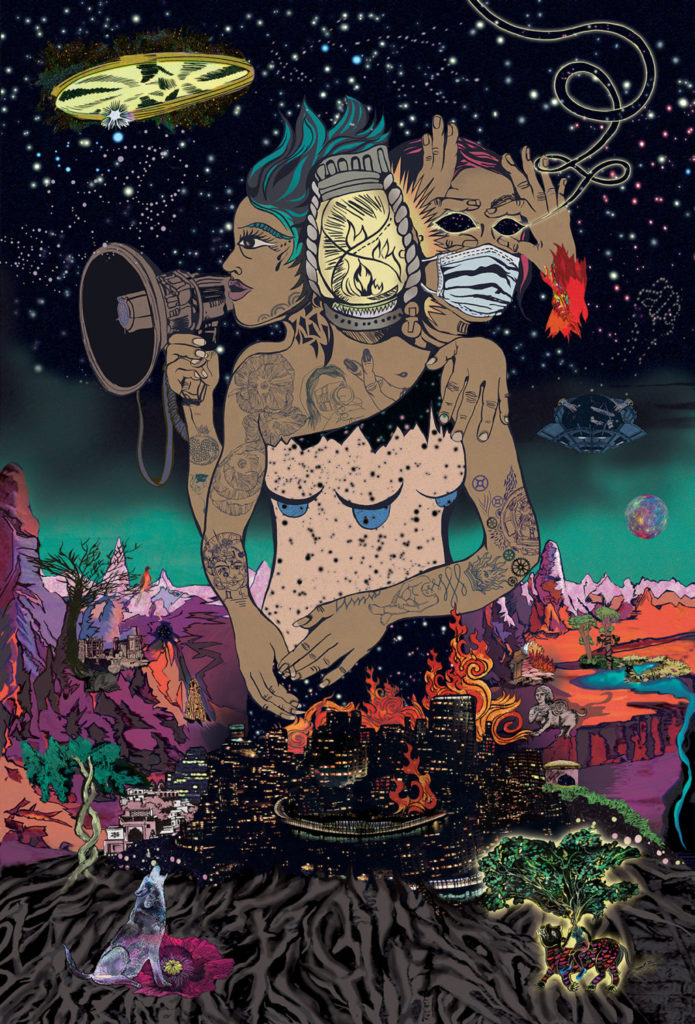
Chitra Ganesh: Multiverse Dreaming: Urgency, 2020. Archival digital print. 66 1/4 x 45 inches. (Courtesy of the artist and Gallery Wendi Norris, San Francisco)
Chitra Ganesh also borrows from both fantasy and folklore in her intensely detailed re-imaginings of popular but problematic Indian illustrated stories. Both a valuable tool in keeping traditional cultural foundations alive for modern comics-obsessed youth and also a frequent source of reinforcement of toxic stereotypes, Ganesh reclaims the power of this legacy and reframes its female figures in new, empowering contexts. Adept at the intertwined visual language of both comics and Indian fine art vernacular, and with a saturated, eccentric palette and a flair for energetic action, this work speaks to the past and present, but also feels at home in the metaverse of the future.
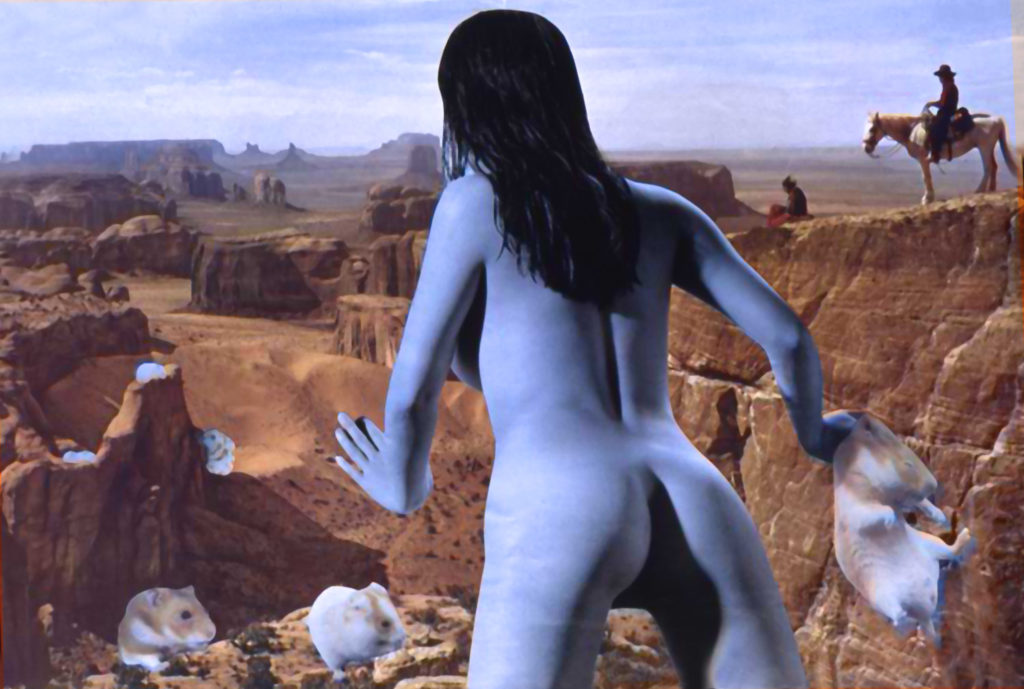
Marnie Weber: Blue Nude With Hamsters, 1997 (Courtesy of the artist and GAVLAK, Los Angeles and Palm Beach)
Marnie Weber performs a similar search and rescue in classic early collage works from 1997-1998, removing women from skin mags and creating new worlds for them to inhabit — surreal, intriguing, hospitable. Often in the company of animal companions and in desert landscapes of majestic power and sheltering skies — as in the cinematic proto-meme masterpiece Blue Nude with Hamsters — but always with the eccentric, jaunty sense of the strange that Weber is known for. Although the central images themselves, the tropes of the commodified female nude, remain unchanged, through the essential and conceptual operations of the collage medium, they are nevertheless remade by their transportation into figures of self-determination, sisterhood, and almost shamanistic power.
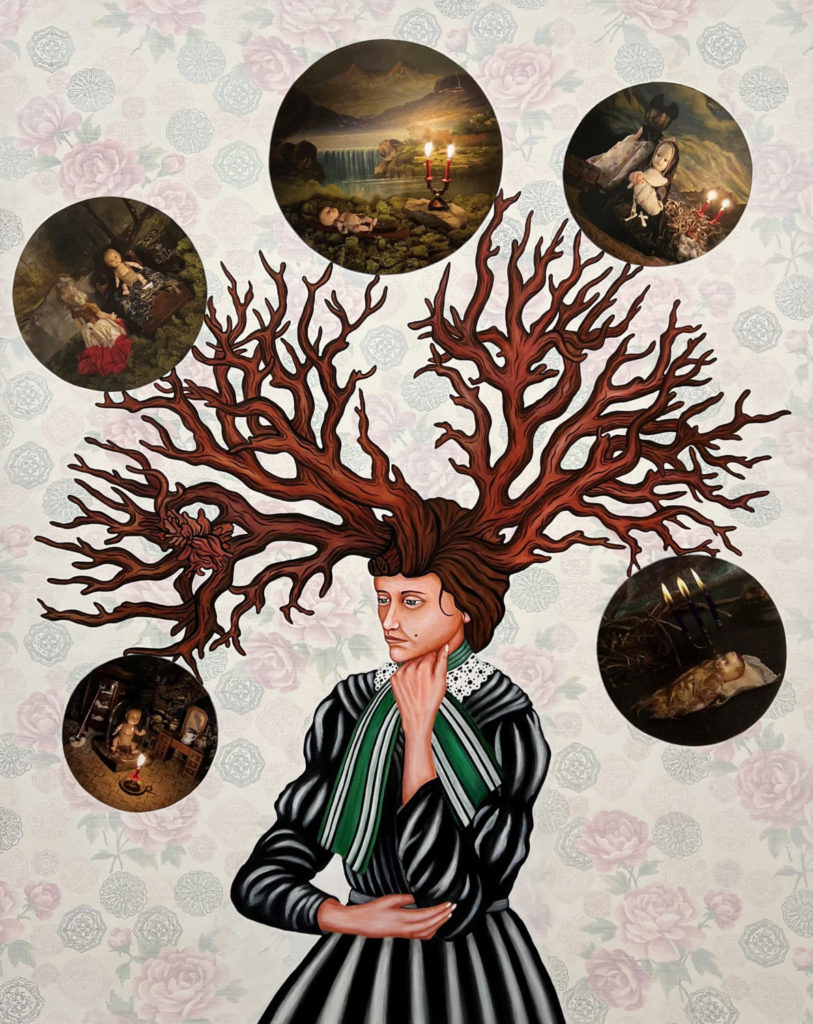
Lezley Saar: Lady Audrey, 2011. Acrylic and digital photographs on fabric and board. 40 x 32 inches (Courtesy Walter Maciel Gallery)
Lezley Saar also has a knack for “rescuing” heroines from art, literature and history, reclaiming stories of women and especially black women who insisted on existing outside the proscribed lines of gender, race, and patriarchal religion, often at great personal peril. Women labeled as mad, as witches, as frigid, as perverted; women who dressed and lived as men; those who passed as white; those who sought refuge in and from marriage… Saar’s thoughtful paintings and collages redraw ancestral lineages and illustrate connectivities among these historical and present-day communities in which she sees herself reflected.
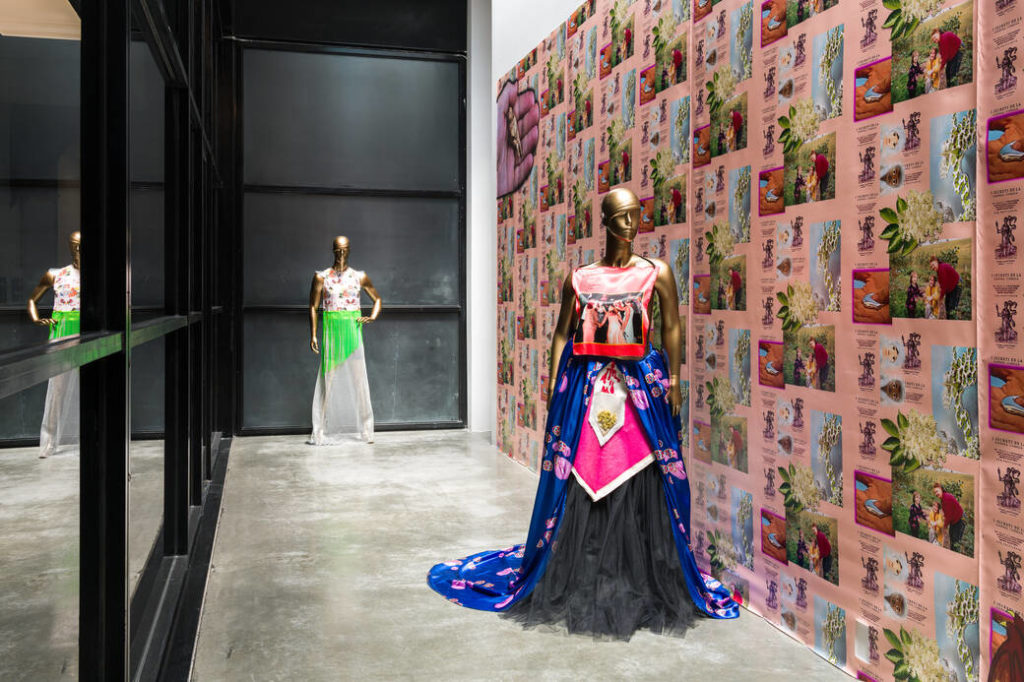
Molly Surazhsky: Garment #8 (Mashacare SS19′ Fashion Show) (2019); Blossoming, Blooming, Beaming vinyl wallpaper (2019); and Unchained (2019), in Cantos of the Sibylline Sisterhood (Courtesy ArtCenter College of Design. Photo: Ruben Diaz)
Molly Surazhsky actually also uses mannequins and conceptual garments, as well as the creation of a utopian, care-based world, in her installation. Within an expanded fashion-framed motif, the artist creates a storefront-scale photomontage and altar in homage to the women in her family, whose fortitude and folk medicine have ensured the line’s survival through war, migration and diaspora. The Revolution School focuses on healing and folk wisdom – as a cohort of multidisciplinary, systems-minded artists – explores the collective potential of magic, technology, the microbiome, game theory, digestion, metaphor, anti-trauma therapy, and collective dreaming to generate a better future for everyone.
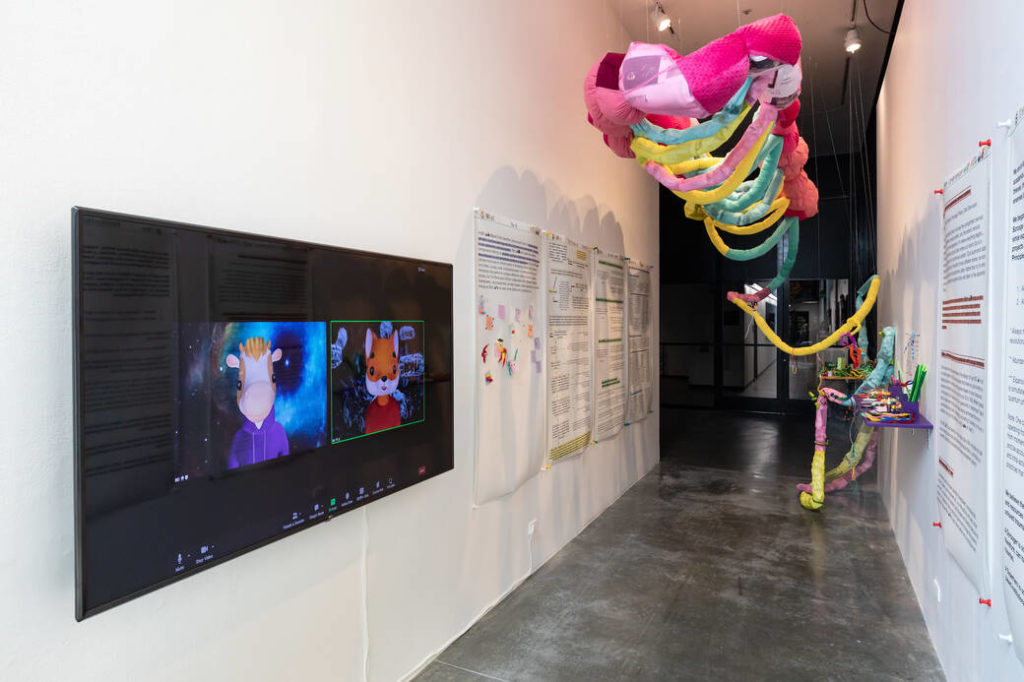
The Revolution School: Imagine a liberated world beyond binaries, hierarchies and capital (2022), What is a BEI? (2022), Thinky Feely Tank (2022), My Little BEI (2022), and Sci-Fi Fair (2022), in Cantos of the Sibylline Sisterhood (Courtesy ArtCenter College of Design. Photo: Juan Posada)
Erica Ryan Stallones messes with time streams, too. In marvelous, strange tableaux paintings and accompanying audio tracks, she guides audiences through a collapsed psychological realm of archetypes from the Jungians to the ancient Greeks and Egyptians, to global folk and indigenous icons, to the alien visitors whose presence and awareness has and continues to connect and inform it all. Mariko Mori — the soundtrack for whose upbeat and ethereal 1996 video Miko No Inori permeates and enchants the entire exhibition space — explores the union of the bodhisattva, the human woman, and the cyborg in a new kind of being with a heroine’s journey through ancient archetypes in the present and future. Like so much of the work in the exhibition, whether made as recently as last year or presciently made decades ago, Mori’s videos begin with a feminist point of view but expand in every direction to encompass the whole of humanity, honor and ameliorate the past, and plot the possible future.
On view through Nov. 23, at the Alyce de Roulet Williamson Gallery, ArtCenter College of Design Hillside Campus, 1700 Lida St., Pasadena; free; artcenter.edu.
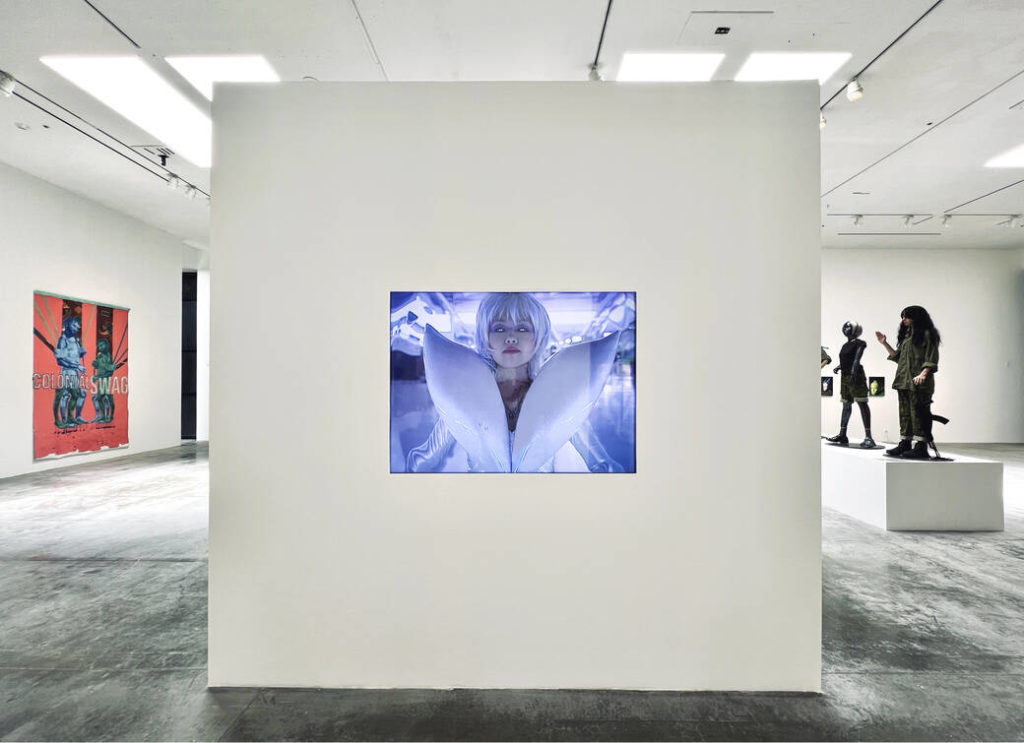
Mariko Mori: Miko No Inori (1996), in the ArtCenter exhibition Cantos of the Sibylline Sisterhood (Photo by Julie Joyce)
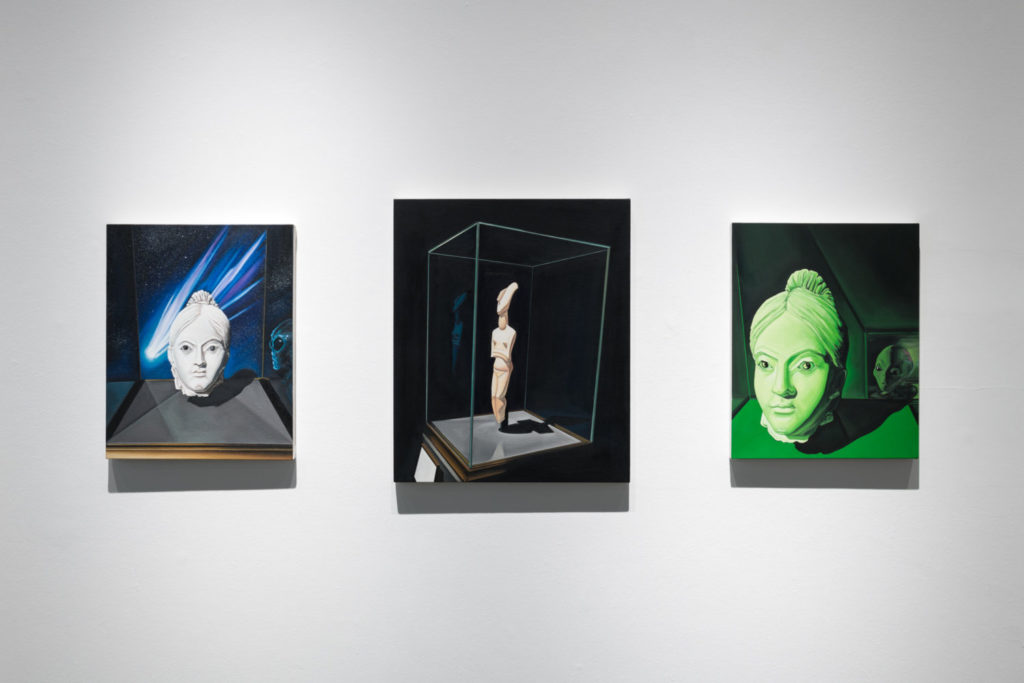
Erica Ryan Stallones: The Inner Apartment (2020), I am again in the Current which also is myself (2020), Then I saw a second one (2020) from the Visitation Station series, in Cantos of the Sibylline Sisterhood (Courtesy ArtCenter College of Design. Photo by Ruben Diaz)
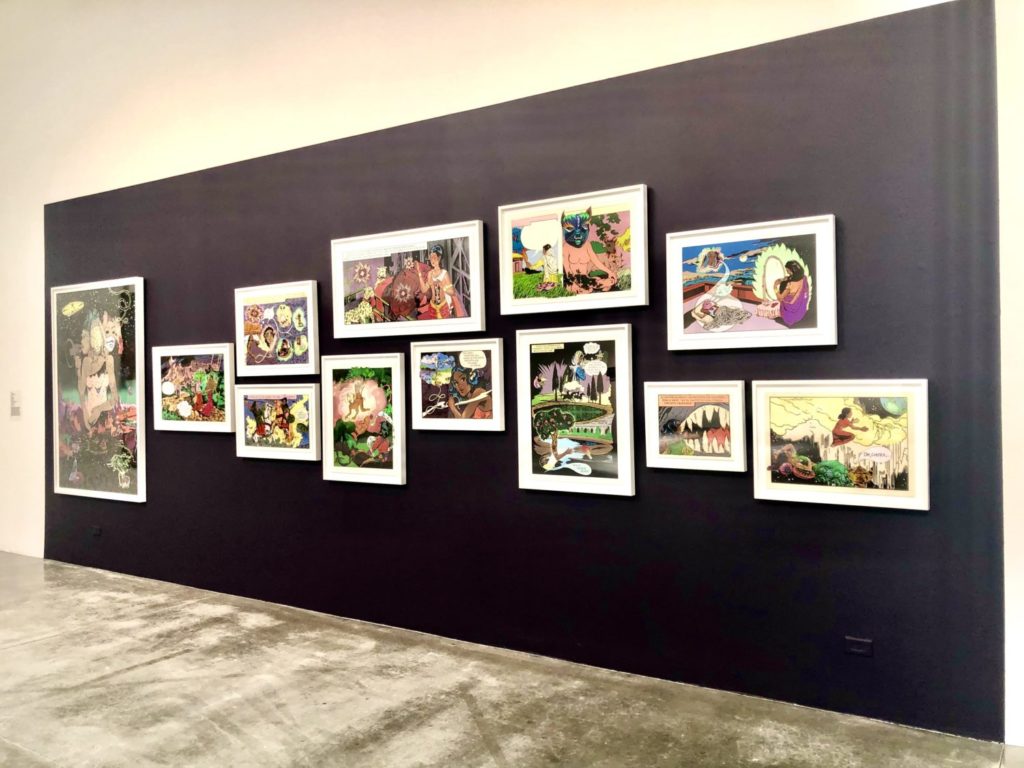
Chitra Ganesh in Cantos of the Sibylline Sisterhood at ArtCenter (Photo by Shana Nys Dambrot)
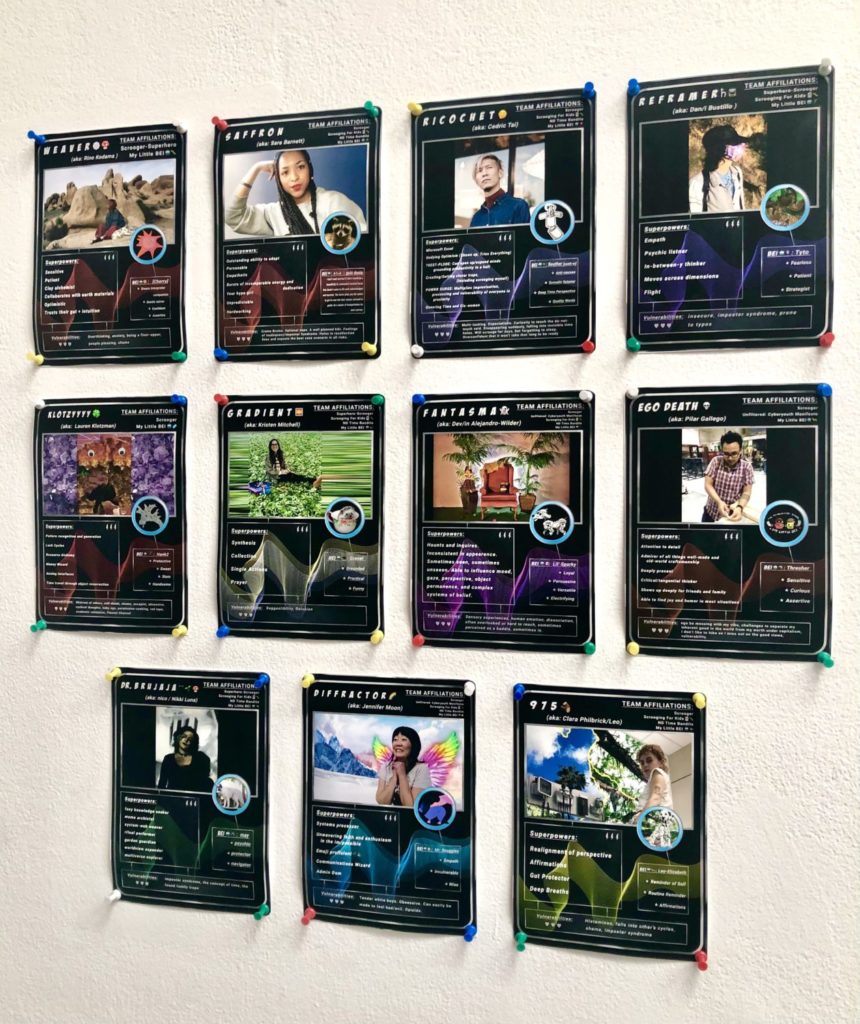
The Revolution School (Photo by Shana Nys Dambrot)
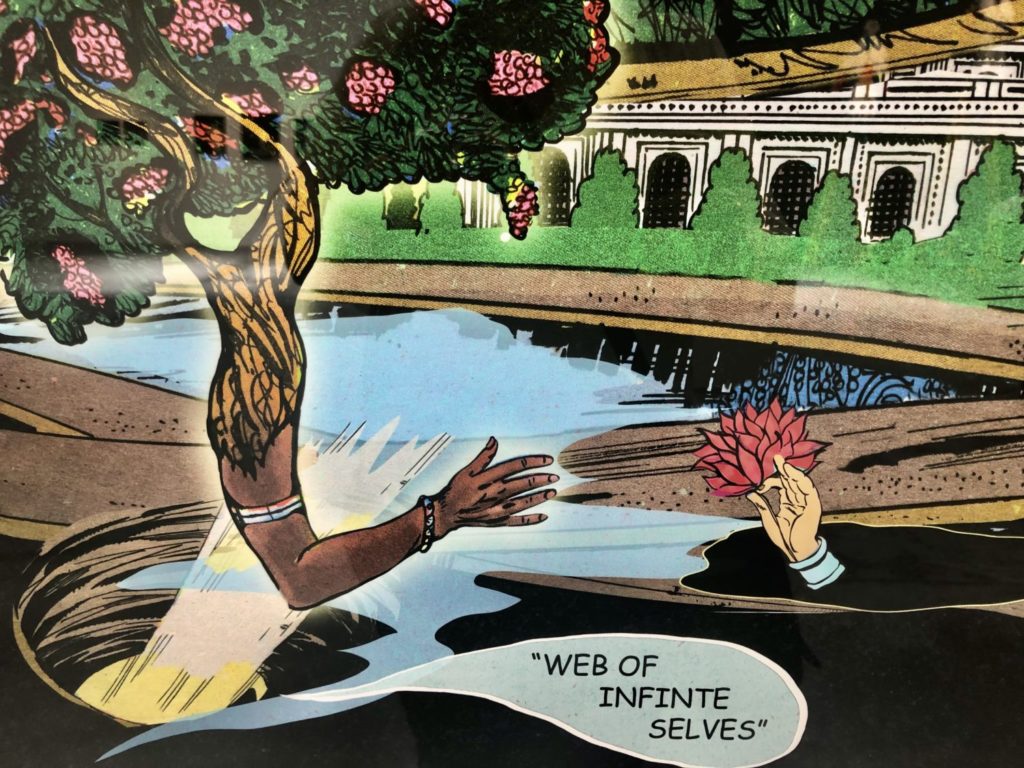
Detail of work by Chitra Ganesh (Photo by Shana Nys Dambrot)
Editor’s note: The disclaimer below refers to advertising posts and does not apply to this or any other editorial stories.
Advertising disclosure: We may receive compensation for some of the links in our stories. Thank you for supporting LA Weekly and our advertisers.

